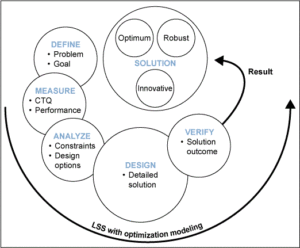isixsigma.com

Common Mistakes When Using SIPOC
Updated:What are the most common mistakes when using SIPOC? The SIPOC Diagram is one of the most useful tools in your arsenal when it comes to process analysis. It readily allows you and your team to grasp the various elements of a process before diving fully into detail on how everything fits together. That said, […]
Read more »
Lean Lego Game: Get Your Team Understanding Lean Principles While Having Fun
Published:One of the best ways to introduce people to new concepts is through a hands-on, team experience. Better yet, a game! Dig out some Legos and let the Lean Lego Game begin!
Read more »
Sigma Performance Levels From One to Six Sigma: Get the Most Out of Your Processes
Published:When learning about Six Sigma, it may help to consider these charts. These detail how Sigma Performance Levels relate to defects per million opportunities (DPMO), and some real-world examples. Sigma Performance Levels Table Sigma Performance Levels – One to Six Sigma Sigma Level Defects (or Errors) Per Million Opportunities (DPMO) Yield (or Produced […]
Read more »
Pugh Matrix: Learn How This Tool Empowers Your Decision-Making Process
Updated:You are often faced with many options on how to improve the process. Which one is the best? The Pugh Matrix is a simple tool for you to decide which approach — or hybrid of approaches — you should use.
Read more »
MVP (Minimum Viable Product): From Concept to Reality
Published:In the world of startups and product development, the Minimum Viable Product (MVP) has become a cornerstone of agile innovation. An MVP is a product with just enough features to attract early adopters and validate a product idea. It allows businesses to test their hypotheses and gather valuable feedback without expending excessive resources. […]
Read more »
How to Write an Effective Problem Statement: Get to the Root Cause Without the Fluff
Updated:Continuous improvement specialists are challenged to solve problems for their organizations or clients. They have acquired a wide array of tools, methods, and techniques for that purpose. If continuous improvement practitioners can establish the winning conditions for change, they can look forward to successful outcomes. However, the devil is in the details, making continuous improvement […]
Read more »
How AI Is Changing the Nature of Work Across Industries
Updated:If you haven’t paid attention to the news over the last two years, you’ve likely missed the buzz surrounding AI. Artificial intelligence has touched down in a big way over the last couple of years. Products and services like ChatGPT, Midjourney, and Google Gemini have entered the cultural zeitgeist. Now, that’s fine and […]
Read more »
Sigma in Statistical Analysis: What You Need to Know
Updated:Sigma is the eighteenth letter of the Greek alphabet and is used as a common notation in statistics as a measure of summation and variation.
Read more »
Sigma Level: Striving for Perfection in Your Production
Published:Learn the benefits of tracking sigma level, including how it is used to understand how the current quality capabilities match with customer expectations, where future process improvement opportunities lie, and how to verify results.
Read more »
The 8 Wastes of Lean: Understanding and Addressing Them in Your Organization
Updated:Waste is all around your organization. Using TIMWOODS and DOWNTIME, you will learn how to identify the 8 Wastes of Lean and eliminate it to improve your organization.
Read more »
Process Improvement in the Age of Smart Manufacturing
Published:Process improvement projects have typically been a labor-intensive and imprecise process. Labor-intensive in that capturing the as-designed vs the actual current-state process required facilitated meetings, interviews, surveys and analyzing operational data over an extended time period. Imprecise in that workers will typically act differently when they know they are being watched and measured. The Hawthorne […]
Read more »
Incorporate Lean Six Sigma in Automation Process
Updated:Lean Six Sigma can assist organizations determine which processes are the best candidates for automation as well as make those processes more automation ready.
Read more »
Case Study: Using Six Sigma in a Non-Six Sigma Culture
Updated:Anyone who has worked in manufacturing has probably experienced some level of finger-pointing when shipments fall short of expectations. Though there could be multiple reasons for a missed customer delivery, somehow it is always the other department’s fault. In extreme circumstances, several months of missing targets without effectively defining the root causes and addressing them […]
Read more »
The Road to Success: How KPIs Support Goal Achievement
Updated:Key performance indicators (KPIs) are critical to ensuring a project team has the performance data it needs to sustain improvements. With KPIs, a team can evaluate the success of a project against its established goals. Types of Metrics There are two types of metrics to consider when selecting KPIs for a project: outcome metrics and […]
Read more »
Process Capability – Surface Finish Example: Part 2
Updated:In Part 2 we look at failure rates and material conditions for a surface finish example.
Read more »
Use “Light” Lean Six Sigma When the Textbook Approach Is Not Possible
Updated:Practitioners cannot wait to use their newly acquired knowledge after they have finished Lean Six Sigma (LSS) training. They want to immediately apply the framework to their real-life projects. But what if, for numerous reasons, it is not possible to “go by the book”? In such cases, there are ways to break LSS down into […]
Read more »
Process Capability – The Basics: Part 1
Updated:In Part 1, we explore the concept of process capability, including how to calculate it and what to do with non-normal data.
Read more »
U.S.A.F. Uses Continuous Process Improvement on the B-2 Bomber: Part 2
Updated:In this case study, the 509th Maintenance Group of the U.S. Air Force used an eight-step continuous improvement approach to balance its resources and meet both flying hour program requirements and aircraft availability. Part 1 focused on steps 1 through 4. Part 2 looks at continuing to make improvements with steps 5 through 8. Step […]
Read more »
Use a Classification and Regression Tree (CART) for Quick Data Insights
Updated:In the Analyze phase of a DMAIC (Define, Measure, Analyze, Improve, Control) Six Sigma project, potential root causes of variations and defects are identified and validated. Various data analysis tools are used for exploratory and confirmatory studies. Descriptive and graphical techniques help with understanding the nature of data and visualizing potential relationships. Statistical analysis techniques, […]
Read more »
U.S.A.F. Uses Continuous Process Improvement on the B-2 Bomber: Part 1
Updated:In this case study, the 509th Maintenance Group of the U.S. Air Force used an eight-step continuous process improvement approach to balance its resources and meet both flying hour program requirements and aircraft availability needs. This week looks at steps 1 through 4. Part 2 looks at steps 5 through 8. Introduction The B-2 bomber […]
Read more »
Project Examples from an LSS Deployment for Cultural Transformation
Updated:My company benchmarked against other manufacturing businesses before starting its cultural transformation change. They formed a team and visited companies including Toyota, GM, Milliken, Caterpillar, John Deere, Chrysler, Du Pont, and Johnson Controls. After talking to each company about their cultures and continuous improvement processes, my company started to put together a roadmap for transformation. […]
Read more »
Short-Run Statistical Process Control Techniques
Updated:Short production runs are a necessity in high-mix, low-volume manufacturing environments. The trend in manufacturing has been toward smaller production runs, with production runs – as well as products – tailored to the individual customer’s needs. Although this minimizes inventory and improves responsiveness to the customer, it complicates the application of statistical process control (SPC). Classical […]
Read more »
Six Steps to Effectively Plan for Lean Six Sigma Efforts
Updated:Some of the complaints commonly levied against continuous improvement deployments is that they focus on the wrong issues, and that projects take too long or require too much investment (time, training and financial) in order to achieve meaningful results. Unfortunately, these complaints are often justified – not because of some fault in the Lean Six […]
Read more »
Avoid Two Common Mistakes in Measurement System Analysis
Updated:Measurement system analysis (MSA) determines whether the measurement system is adequate and confirms that significant error is not introduced to the true value of a process characteristic. MSA is the one of the most misunderstood and underused concepts in Six Sigma. This article highlights two of the common mistakes made during the study and explains […]
Read more »
Understanding Permutations and Combinations
Updated:In Six Sigma problem solving, it is often important to calculate the likelihood that a combination of events or an ordered combination of events will occur. Understanding some of the basic concepts of probability provides practitioners with the tools to make predictions about events or event combinations. This provides a good foundation for understanding probability […]
Read more »
Use Multiple Process Improvement Methodologies to Strengthen Results
Updated:There are many process improvement methodologies – Six Sigma/DMAIC (Define, Measure, Analyze, Improve, Control), Lean, Design for Six Sigma (DFSS) and innovation to name merely a few. But with so many choices, it makes applying an improvement methodology difficult. There are questions such as: “What makes this toolset unique?” and “Which one should I be […]
Read more »
5 Suggestions for an OpEX Practitioner in a Digital World
Updated:The Lean Six Sigma (LSS) Green Belt and Black Belt curriculum needs an overhaul. The original operational excellence (OpEx) Lean Six Sigma methodology developed by Motorola in the 1980s and made famous by Jack Welch at General Electric (GE) in the early 1990s is finding itself a bit long in the tooth in comparison to […]
Read more »
Case Study: 5S in Practice
Updated:5S is a Lean tool that helps in workplace organization. The following is the list of five Japanese words and their translation in English. (Seiri) Sorting and prioritizing: Going through all the tools, materials, etc., in the work area and keeping only the essential items. Everything else is stored or discarded. (Seiton) Straighten or set […]
Read more »
A Study of Estimates of Sigma in Small Sample Sizes
Updated:This paper looks at some of the methods of estimating standard deviation (which I will usually refer to as ‘sigma’). Additionally, I propose a new formula for estimating sigma for small sample sizes and also present a means to mathematically evaluate these competing estimates of sigma. The question was posed to me: “I have five […]
Read more »
A Macro That Writes Macros
Updated:If you are like me, you may find yourself writing a fair number of MS Excel macros to automate repeatable tasks. One day it dawned on me, however, that several of the aspects of writing macros were repeatable tasks themselves. When writing a macro I would often start by: Creating a data structure that would […]
Read more »
Overview of Effective Survey Design
Updated:The survey is one of the most important data collection tools in the armament of a Six Sigma practitioner. There is no lack of research literature on the principles and designs of effective surveys. While the surveys conducted by academics and certain research institutes often reflect impeccable design, there are innumerable cases in which the […]
Read more »
Case Study: Increase Revenue by Decreasing Prices
Updated:A division of a diversified organization develops and manufactures samples of new drugs for clinical trials. This work entails different typical manufacturing problems for the following reasons: Quantity requirements can vary from a few grams to several tons from order to order. The effort of research and development (R&D) is central; new processes have to […]
Read more »
The Five Fundamental Assumptions of Six Sigma
Updated:Some people are angry and upset about the effectiveness of Six Sigma as a problem-solving discipline. Individuals routinely call for the next new quality discipline or argue why Six Sigma will not work in this case or the other. Some of this is one-upping – this approach is better; some of this is sour grapes […]
Read more »
How Lean Six Sigma Practices Helped Amazon Web Services Achieve Operational Excellence
Updated:In today’s highly competitive business landscape, organizations are constantly seeking ways to improve their operations and deliver exceptional value to their customers. One such company that embarked on a transformative journey is Amazon Web Services (AWS), the cloud computing arm of Amazon. Facing significant challenges, AWS turned to Lean Six Sigma practices and tools to […]
Read more »
How Lean and Six Sigma Dramatically Improved InterConnect’s Kit Manufacturing Line
Updated:InterConnect Wiring was constantly needing to be ahead of schedule in assembling its aircraft kits, causing unneeded stress and an unbalanced workload. By utilizing Lean and Six Sigma concepts, the organization was able to make significant improvements to its processes. Despite already being a very successful organization, InterConnect Wiring was able to utilize Lean and […]
Read more »
How Lean Six Sigma Helped Grupo Bimbo Stay Relevant and Retain Global Market Share
Updated:Established in 1945 in Mexico City, Grupo Bimbo became a global leader in the baking industry, known for its commitment to quality and innovation. As the company expanded its operations worldwide, it encountered various challenges that threatened its profitability and market position. In response, Grupo Bimbo made a strategic decision to implement Lean Six Sigma […]
Read more »
Lean Six Sigma Transformation: Harnessing DMAIC to Enhance Operational Efficiency and Customer Satisfaction at Avon
Updated:Efficiency, Elegance, and Empowerment: Avon and Lean Six Sigma Unite In the bustling world of cosmetics, where beauty meets business, one name has stood the test of time, captivating hearts and empowering women for over a century: Avon. From its humble beginnings as a perfume company in the late 19th century to its global presence […]
Read more »
How Dr Pepper Embraced Lean and Six Sigma Methods, Creating an Economic Impact of Over 100 Million Dollars for the Company
Published:By employing Lean and Six Sigma techniques, Dr Pepper was able to embark on a journey that prioritized Rapid Continuous Improvement, a strategy that led to a number of savings for the organization that totaled over 100 million dollars. Dr Pepper Had a Problem Dr Pepper’s history traces all the way back to 1885 and […]
Read more »
How Value Stream Mapping Helped Increase a University’s MBA Enrollment by 70%
Updated:The University of North Alabama had been part of the steady decline nationally in students enrolling in MBA programs. In order to turn the tide at the UNA College of Business, a team utilized Value Stream Mapping. By focusing on adding value to the student recruiting process, UNA College of Business was able to dramatically […]
Read more »
Project Sponsor vs. Deployment Champion in Six Sigma: What’s the Difference?
Updated:What is a Project Sponsor? A Six Sigma project sponsor plays a key role in Six Sigma methodology who provides overall support, guidance, and resources to ensure the success of a Six Sigma project. The project sponsor is typically a high-level executive or manager within the organization who has the authority to allocate resources and […]
Read more »
Black Belt vs. Master Black Belt in Six Sigma: What’s the Difference?
Published:What is a Black Belt (BB)? A Six Sigma Black Belt (BB) is a trained and certified professional who has achieved a high level of expertise and experience in the Six Sigma methodology. Six Sigma is a data-driven methodology and management philosophy that aims to improve the quality of processes, reduce defects, and minimize variability […]
Read more »
How Lean Six Sigma Tools and an Acceleration Technique Reduced Baggage Connection Delays by 65%
Updated:In 2016, Kenya Airways embarked on a project to increase its baggage handling efficiency. The way that it applied tools from both Lean and Six Sigma methodologies showcases how adaptable these concepts can be and that they are applicable well beyond the industries that they are most commonly associated with. Kenya Airways was able to […]
Read more »
Six Sigma vs. Agile: What Are the Differences?
Updated:What is Six Sigma? Six Sigma is a disciplined, data-driven approach and methodology used by organizations to improve their processes and reduce defects or errors. It was originally developed by Motorola in the 1980s and has since been adopted by numerous companies across various industries. The term “Six Sigma” refers to a statistical concept that […]
Read more »
Kienle + Spiess Tackles Welding Issues with Lean and Six Sigma Integration
Updated:Kienle + Spiess is a German mechanical engineering company that was looking to strengthen its welding division by reducing its rework and improving its quality. To accomplish this, the organization utilized a dual approach where Six Sigma and Lean methods work in tandem. Kienle + Spiess was able to practically eliminate shoddy splatter from the […]
Read more »
Black Belt vs. Green Belt in Six Sigma: What’s the Difference?
Published:What is a Black Belt (BB)? A Six Sigma Black Belt (BB) is a professional who has achieved a high level of expertise in the Six Sigma methodology. Six Sigma is a disciplined, data-driven approach to process improvement that aims to eliminate defects and improve the quality and efficiency of business processes. The Benefits of […]
Read more »
Quality Control vs. Quality Assurance: What’s the Difference?
Updated:What is Quality Control (QC)? Quality control (QC) is a product-oriented approach to quality to ensure that products or services meet specified quality requirements and standards. Quality control focuses on inspection and testing to verify that a product is safe and effective after production. It is often viewed as a process of detection versus prevention. […]
Read more »
Six Sigma vs. Lean: What’s the Difference?
Updated:What is Six Sigma? Six Sigma is a quality control methodology that is utilized to improve processes through the elimination of defects. In practice, the methodology incorporates project management, analysis, and statistics to improve the functionality of a business by addressing defects in a process. The cornerstone of the Six Sigma method is the DMAIC […]
Read more »
How Abbott Utilizes Six Sigma Methodology to Enhance Business Processes
Updated:Abbott, a global healthcare company, has successfully employed the Six Sigma methodology to improve various aspects of its business operations. By leveraging this data-driven approach, Abbott has achieved significant advancements in efficiency, quality, and customer satisfaction. Abbott’s Journey to Transform Business Processes: Tackling a Critical Challenge Abbott, a leading healthcare company, has built its reputation […]
Read more »
How DMAIC Helped San Antonio Increase the On-Time Payment of Street Maintenance Contractors by Nearly 20%
Published:We all need payment for the work that we do. It is really that simple. If contracted out to do a job by somebody, you need to be able to count on compensation for the work done on that job within a reasonable amount of time. Contractors that worked on street maintenance projects for the […]
Read more »
How the Six Sigma Quality Improvement Process Practically Eliminated False Fire Alarms at US West
Published:In the early 1990s, US West was an organization that was leading the charge in telecommunications. At the time, their buildings were being plagued by disruptive false fire alarms. How it was dealt with is a great example of how to apply the Six Sigma quality improvement process, a method applicable to nearly any quality […]
Read more »